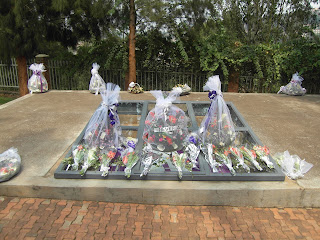Day
4
At 4am, an African storm rushes
over our dormitory, a stampede of raindrops drums our tin roofs and soaks the
walkways, lightning flashes, thunder claps, and we can still hear our resident
bats squeaking in the darkness. Though all of us students wake up, our faculty
members, Steve, Tim, and Lama, sleep soundly beneath their grass roofs.
After breakfast, yes, plantains,
eggs, fruit…we have a meeting to discuss how we are all feeling: mind, body,
and spirit. In general, it sounds like no one is getting enough sleep, perhaps
because of jetlag. Everyone feels spiritually connected to Rwanda and very much
at home.
“We can only do so much,” Lama
reminds us. We have to keep our own health in mind.
We head to Covaga to teach our
first English lesson. When we enter the cooperative, the women look up from
their weaving with broad smiles on their faces. They’ve kicked their sandals
off and their bare feet sway casually. After Lama explains that we’ve come to
teach them English, they start to squish together to make room for us on their
straw mats.
Lindsey and Sara act out a basic
conversation which includes “Hello,” “My name is…,” and “Nice to meet you.”
Lama lets the women know the translations and we group up and practice. The
women stare at our lips and repeat our words slowly, squealing and grabbing our
hands and clapping when they get the pronunciation right. Some women are
enthusiastic about learning and find paper and pens to write down the English
phrases. We hope that the English will help the women sell their baskets to
visitors in the future.
When it’s time to leave, the women
start giving us gifts. At first we feel awkward, unsure of whether we can
accept the gifts. But the women insist. They also insist on having their photos
taken, although we often have to convince them to smile. They wrap
their arms around us, and gently place baskets, earrings, and bags into our
hands. It’s what Tim calls a “tender moment.”
During lunch at our usual
place, Yvone’s, Cedric leads us in
a song to learn the numbers in Kinyarwanda. We get to number six before things
become difficult. After he finishes eating, Rogers starts to play Taylor Swift
on his computer, and we can’t help but laugh.
We then split up and some students
return to the medical center. Upon arrival, the staff looks prepared with pens
and paper in hand. They are eager to learn. Our group is still unsure about how
much time we are able to commit. The public health educators wish to be
educated about nutrition, and since none of us students study nutrition,
Filimon and Carrie, the students interested in community health, will do some
research. The public health educators tell people to eat a balanced diet but don’t
have a comprehensive description of what that means.
Lama says that a balanced diet
contains four different colors: yellow, red, green, and white (plus fruit). He
tells a story of how Rwandans used to cook beans all day, but then they learned
that they could soak the beans overnight and then would only need to cook them
for one hour. It’s basic knowledge like this that some Rwandans still lack.
Instead of going to the medical
center, Nicole, Brooke, and Lindsey take a longer walk back to the hotel.
Before long, they acquire a group of children shouting, “MUZUNGU,” and rushing
to hold their hands. They decide that finding a field and starting a soccer
game sounds like a good idea.
They find a field, but the “soccer”
game ends up consisting of a group of kids playing keep away. Nicole, Brooke
and Lindsey decide they should head back. When they start walking, they say,
“Murabeho” (Goodbye) to the children. Usually the kids understand that this
means it is time for them to head home. This time it doesn’t work. The kids
keep walking, big-eyed, curious, and grasping for hands. Nicole, Brooke, and
Lindsey hold their hands above their heads to keep the kid’s from holding them
and say, “Oya” (No). Nicole is a sucker though, and they quickly have their
hands full again.
Once they make it to the main road,
they create a large gap but the kids keep on coming, now far from home. Eventually Brooke, the
stern education major, stops and encourages the kids to go back. This works and
before long the kids say goodbye.
In Rwanda, the Muzungus
(Westerners) are like celebrities. Everyone in the community stares at us,
because staring is not taboo in Rwanda. The children shout and wave from their
clay homes as we walk by. Some stand shy, swaying with their hands behind their
backs, and say in their best English, “Good Morning” (whether it’s day or
night).
Sometimes, they’re so cute, it’s
hard to shake them off.






